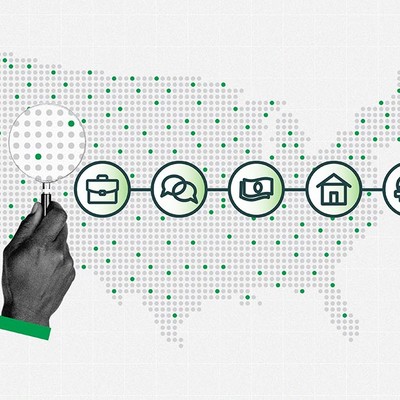WASHINGTON, D.C. -- Twenty percent of U.S. adults in Gallup's most recent quarterly data report feeling loneliness “a lot of the day yesterday,” a slight uptick in the rate after several quarters when it hovered around 17% or 18%. Still, the current rate remains lower than the 25% highs measured three times -- most recently in March 2021 -- during the COVID-19 pandemic. These data are a part of the Gallup National Health and Well-Being Index.
In 2023, the Surgeon General declared a loneliness epidemic in the U.S. Although progress has been made in reducing loneliness in the U.S. since the pandemic, a significant number of U.S. adults -- an estimated 52 million, based on Gallup’s current estimate -- still struggle with it.
The most recent results, obtained Aug. 27-Sept. 4, 2024, are based on 6,289 U.S. adults surveyed by web as a part of the Gallup Panel, a probability-based panel of about 100,000 adults across all 50 states and the District of Columbia.
The increase in loneliness to 20% is a deviation from recent trends, reflecting a two-percentage-point increase since last quarter and a three-point increase since the start of 2024. Gallup does not have pre-pandemic measures of loneliness, so it is unclear whether the current level represents a return to prior estimates or is higher than those estimates would have been, even though the pandemic has ended.
Loneliness More Linked to Current Life Ratings Than Future Life Ratings
Significant daily loneliness in the U.S. is closely linked to many aspects of wellbeing, including current life satisfaction and anticipated life satisfaction in five years.
Those experiencing daily loneliness are nearly five times as likely as those who do not report daily loneliness to rate their current life poorly (14% to 3%, respectively, based on giving a 0-3 rating on the 0-10 Cantril Self-Anchoring Striving ladder scale).
Loneliness and expectations for one’s future life are also related, but the association is weaker than for loneliness and current life evaluations. A low rating on future life is 2.5 times more likely when adults experience daily loneliness (10% vs. 4%), about half the effect found for current life satisfaction and suggesting that hopefulness for the future is not affected as negatively by loneliness as are assessments of one’s current life.
Similarly, lonely and not-lonely adults also differ less on positive reports (7-10 ratings) of their future life than of their current life. Lonely adults are 23% less likely to be optimistic about their future lives than are their not-lonely counterparts (64% compared with 83%). High-end ratings of one’s current life, however, are considerably more eroded in the presence of loneliness: Those experiencing loneliness are 46% less likely to rate their current lives a 7 or higher than those who are not lonely (39% compared with 72%).
Liking What You Do Each Day Linked to Reduced Loneliness
Across over 30 metrics measured as a part of the National Health and Well-Being Index, three stand out as being most closely associated with a reduced probability of experiencing loneliness:
- You like what you do every day.
- Your friends and family give you positive energy every day.
- In the last seven days, you have felt active and productive every day.
In each case, the chances of experiencing a lot of loneliness the day prior are reduced by at least 75% among those who agree that the statement applies to them compared with those who disagree.
Implications
Daily loneliness has fallen five points to 20% since March 2021 (the early days of the COVID-19 vaccine national rollout), but the current reading reflects an uptick to a rate the U.S. has not seen since 2022. Although loneliness has a detrimental impact on general life satisfaction, it is encouraging that it appears to have a smaller effect on how people see their future lives, leaving room for hope. Hope is a powerful feeling that should not be underestimated. It has fostered resilience for those with clinical depression and deterred terminal illnesses like cancer.
From a wellbeing perspective, tangible aspects of life experiences can play a significant role in reducing the chances of experiencing loneliness. Liking what you do each day, a core aspect of career wellbeing, represents having a natural right fit in one’s day-to-day activities. It is also a part of wellbeing that employers can greatly influence. For those who do not like what they do every day, the rates of burnout, unplanned absenteeism and turnover all rise substantially. For organizations, this means adopting a talent-based hiring approach, whereby “square pegs are fit into square holes” can result in mitigating workers’ chances of experiencing loneliness and the mental and emotional health challenges that come with it. For those outside of the workforce, liking what they do every day can include hobbies and activities that use their natural talents. Looking to community programs or volunteer opportunities of interest can bolster human interactions and reduce the chances of suffering from loneliness.
Physical wellbeing, which includes feeling “active and productive every day,” has worsened significantly since before the pandemic. Feeling active and productive, which represents frequent natural movement and having the energy needed to get things done, increases people’s chances of being out and about and interacting with others. Community programs that encourage healthy behaviors, like local exercise and healthy cooking classes, represent one pathway for adults to improve their physical wellbeing that simultaneously reduces the odds of experiencing loneliness. Organizations particularly stand to benefit from communicating the importance of physical wellbeing to managers and reinforcing healthy behaviors that will positively affect the emotional health of workers long term.
Perhaps one of the most powerful post-pandemic changes is the ability to see friends, family and coworkers in person, an important aspect of social wellbeing. As pandemic restrictions for social interaction have retreated, reports of loneliness have generally declined. Organizations can play an important role in reducing loneliness by fostering a culture that promotes and encourages the formation of best friendships in the workplace. Communities have a similar opportunity. Local activities that promote neighborhood participation encourage community members to come together and create memories, ultimately boosting their social connections with one another.
To stay up to date with the latest Gallup News insights and updates, follow us on X @Gallup.
Learn more about how the Gallup National Health and Well-Being Index works.
Learn more about how the Gallup Panel works.





